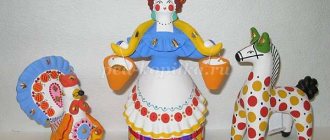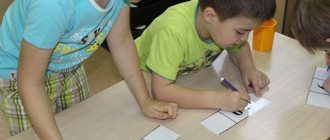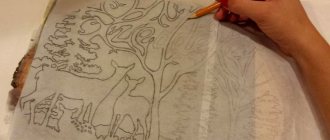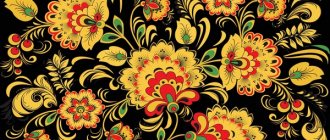Technique for performing Khokhloma painting
(In the artistic painting workshop, Semenov, USSR)
Prepared wood products are dried and primed using wax or liquid clay. The blanks dry for at least 7 hours. Then the wooden surface is carefully treated with drying oil. In total, the procedure must be repeated 3–4 times throughout the day.
The next stage is tinning. Aluminum powder is rubbed into the wood. The procedure is carried out manually using a leather swab. After this, the products become shiny and ready for painting.
Only thin brushes of different “calibers” are suitable for applying the design. The finished drawing is left to dry for a while and then opened with varnish. The final stage is hardening in an oven at a temperature of +160 degrees. It is then that a luxurious “golden” film is formed.
Types of painting
Masters of the direction use two types of writing - top and background. In the final drawing, the artist applies black or red paint to the base. The background painting has a red or black base with a gold pattern.
Horse drawing
The top design involves 3 types of ornament - “grass painting”, as well as stylizations “like a leaf”, “like a berry”, “gingerbread”.
Ornamental options for horse painting:
- “Grass” - sedge, white grass and meadow grass, these are the main elements of the painting. It is written with curls and various strokes, spikelets or berries on a golden background.

- “Like a leaf”, “like a berry” - artists are engaged in stylization of plant forms. This species differs from the “grass” pattern in its larger strokes, which turn into oval leaves, and the round berries are placed with a brush poke.
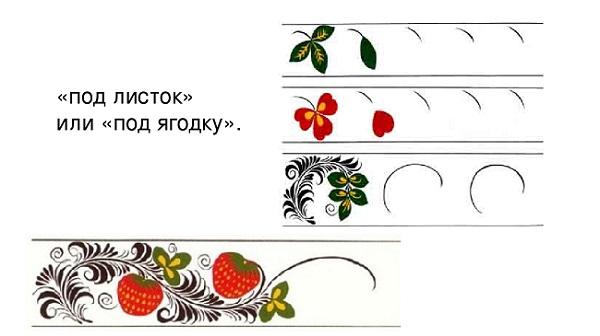
- “Gingerbread” is the name given to a geometric figure that fits into a square or rhombus; in the middle of such a figure is the sun. The peculiarity of this ornament is the apparent movement of the patterns.
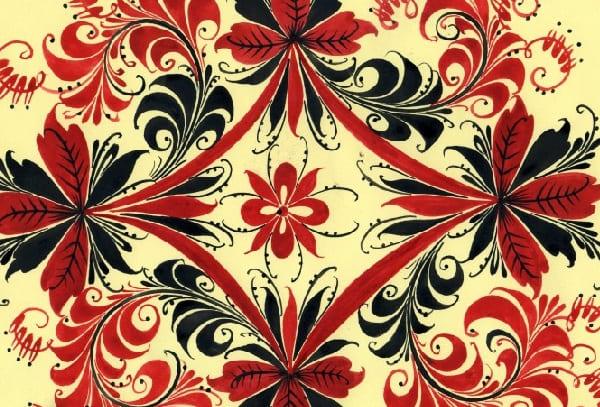
Doing all of these elements requires a skill that needs to be practiced over and over again.
Background image
In this case, it is worth noting two types of ornament - “under the background” and “curly”. “Under the background” is a very labor-intensive, skillful process that not every master could cope with. Usually these works were made for a gift, they were made to order and for a very high price.

The “curl” is dominated not by the stroke, but by the contour line. This painting resembles a carpet; golden curly curls form patterned leaves, flowers and fruits. This image looks very impressive, and the tricolor (red, black, gold) is quite enough for such expressiveness.
Elements and motifs of Khokhloma painting
There are “top” and “background” writing. In the first case, the master forms a pattern on a golden background using black, red and white tones. It is through the example of Khokhloma drawings that one can very clearly examine the entire “soul” of the Russian people, the special presentation, the warm and slightly naive philosophy of life of an entire people. These are his well-known “grass” and “spikelets”, his love for still lifes, where the masters especially generously used bright rich colors, and the ability to create complex compositions using delicate strokes.
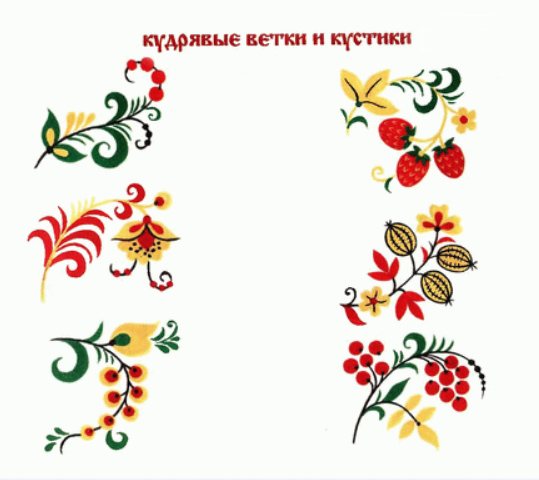
(Branches and bushes)
The grass painting is represented by sedge-like motifs. The oldest type of pattern is written with curls, strokes, small berries, and spikelets on a silvered background. From individual blades of grass, skilled craftsmen could form a motif of a hen or a cockerel, which, for example, sits on a branch among dense foliage;

(Berries and leaves)
“Berry” and “leaf” differ from the previous technique in larger “bold” strokes. Masters form oval leaves and round berries, stylizing compositions with massive plant forms. Particularly popular are patterns with grape bunches or leaves, strawberries, raspberries, blueberries, and large cherries. On a scattering of tulips, asters, buttercups, daisies, and bluebells, the craftsmen managed to arrange currants, gooseberries and rowan;
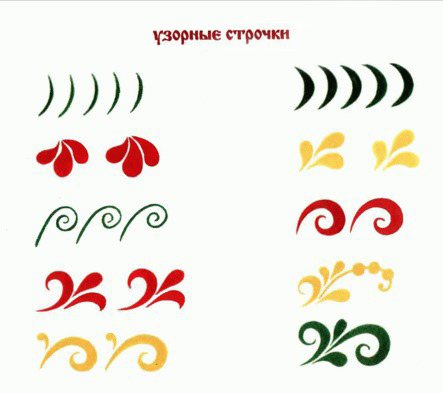
(Stitches and patterns)
“Gingerbread” or “saffron milk cap” is usually made inside cups, dishes, and bowls. These are geometric shapes that fit into a square or rhombus. By . The periphery of the ornament is enriched with miniature details.

(Floral ornaments)
Horse writing is always created with thin, delicate strokes. The composition turns out light and airy, as if illuminated by a golden glow from within. As a rule, this is a fairly simple method of applying paints, allowing you to improvise to some extent, modifying the composition at your discretion in the midst of work.
When writing background writing, a canvas with outline outlines is initially formed. Then the surrounding background is painted over with red and black paint. Background painting is a more complex and time-consuming process. There is no room for improvisation here, and the original idea must be implemented exactly as the master came up with at the very beginning.
History of the fishery
This artistic movement appeared in the 17th century, in the Nizhny Novgorod district. The Volga region village of Khokhloma became famous for centuries to come, and it was the craft of painting wooden utensils that developed there that brought fame to the small settlement. Even before the advent of Khokhloma, the masters of the Volga region were engaged in decorative wood processing: carving, for example, which in a certain sense became the forerunner of painting. This area is also known for icon painters, so there is an assumption that the golden color of Khokhloma wooden utensils is a borrowing of the icon painters’ method of gilding frames.
Perhaps the famous fishery would have had a more modest fate, but the favorable location of the region contributed to, as they would say today, effective marketing. So many people gathered at the fairs in the Volga region that the fame of the painted items shimmering in gold spread far beyond the borders of the Nizhny Novgorod region.

Khokhloma XIX century
But Khokhloma craftsmen did not start with those elegant products that we associate with Khokhloma today. Silver powder, which when processed turned into gold, was too expensive. Therefore, at first they only did the edging of the dishes. And only in the 19th century did they learn to make that same golden background from tin; the cheapness of this method led to the appearance of that very recognizable Khokhloma dishes.
Folk art could have been forgotten in the course of scientific and technological progress that came at the turn of the century: factory-made goods were much cheaper, so the production of painted dishes ceased to have commercial meaning.
And only in the 20s of the last century the craft experienced a renaissance: professional schools appeared, masters began to exhibit their works at international exhibitions, and the world learned what Khokhloma was in those years.
People whose names are associated with Khokhloma painting:
- The Krasilnikovs are a dynasty of outstanding Khokhlomichi, in which five generations were engaged in folk crafts. A.V. Krasilnikov wrote the book “Golden Khokhloma”, a real encyclopedia of craft, a unique work from the point of view of art history.
- Georgy Matveev - founded the school of Khokhloma painting in Semenov. For many years, Georgy Petrovich collected works of folk craftsmen, which subsequently acquired the status of a museum of handicrafts. It is interesting that Matveev learned artistic woodworking in Kholmogory, after being arrested for revolutionary activities.
- Stepan Veselov painted his first spoon at the age of 5, and his father was already selling the works of a seven-year-old boy at a fair. The works of the eminent master are present in the collections of many museums. War wounds could have prevented the continuation of his creative path, but his working hand was not injured, and in the 50s Stepan Pavlovich returned to Khokhloma. Fans of the fishery recognize and honor Veselov’s herbal writing.
The Gushchin dynasty, the Lushin family - such nepotism is not uncommon in the history of the development of Khokhloma. The emergence of new dynasties can continue the ancient craft, giving it the opportunity to experience several more rounds of popularity.
In the 60s of the last century, the Khokhloma Painting artel was transformed into a large factory with the same name. A creative laboratory was opened at the factory; in the 90s, a workshop for making matryoshka dolls and a miniature painting workshop were opened there, and in 2004 a painting section appeared at the factory.
5 years ago, the city of Semenov acquired the status of the capital of Golden Khokhloma, and in the same year the international festival movement of the same name started.
Today, the factory actively produces stylish accessories with already legendary Khokhloma elements. Motifs, patterns, colors every now and then inspire fashion artists to create collections with a Russian mood. Dishes, office supplies, New Year's souvenirs, furniture, miniature works - the list of products produced today in the context of Khokhloma painting is impressively long. And fortunately, products made using recognizable techniques find their buyers all over the world.
Primary colors
The paradox of the Khokhloma folk craft is that having a rather meager set of colors, the artist managed to use it to create patterns whose accuracy and color presentation are impeccable. A distinctive feature of the works is the golden base. Gold could be the background or key elements of the work. The golden color is the very joy of life, wealth and fullness. This is the color of luxury that always looks impressive.

The other two mandatory colors of Khokhloma are black and red. White and ocher became a laconic addition to the designs. They were present in fishing and painting on orange, as well as emerald, scarlet and turquoise backgrounds. But they were less common and did not have the same demand as products with the above-mentioned colors.
One way or another, if you decide to try your hand at Khokhloma, your color palette can easily include:
- black;
- red;
- white;
- orange;
- selected yellow;
- green;
- brown;
- blue;
- emerald.
But the color range is not all the features of the painting. The direction has other tricks that brought it fame.
